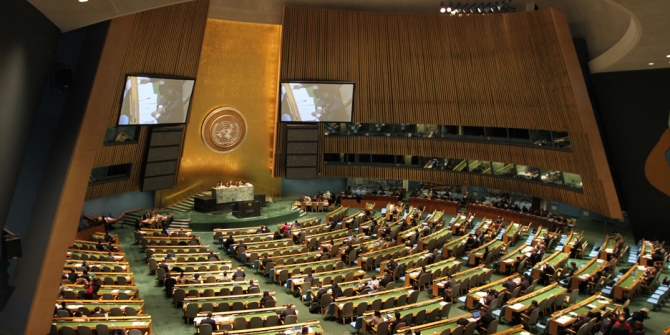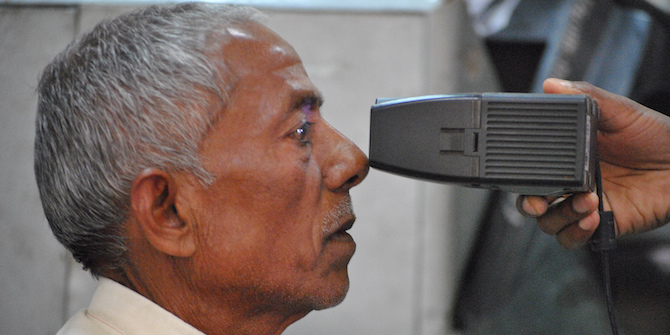 The Economic Survey, for all its emphasis on gender with a pink cover, chooses to tackle the question of gender inclusion in science, by complete silence on the question. While comparing India and Iran, T. V. H. Prathamesh writes that India fares poorly since the lack of policy intervention and funding have systematically reproduced the gender divisions in this sector. Iran, on the other hand, has taken steps to address this issue.
The Economic Survey, for all its emphasis on gender with a pink cover, chooses to tackle the question of gender inclusion in science, by complete silence on the question. While comparing India and Iran, T. V. H. Prathamesh writes that India fares poorly since the lack of policy intervention and funding have systematically reproduced the gender divisions in this sector. Iran, on the other hand, has taken steps to address this issue.
Earlier this year, just before releasing the Budget, India released the Economic Survey 2018. The document, which is perhaps among the more celebrated and comprehensive reports on the Indian economy and its promised trajectories, was coloured in pink to spell out its ‘progressive gender-friendly’ agenda. One way to test the seriousness of such an agenda, would be to see how the agenda manifests itself in its vision for different sectors of economy. Here I explore one suitable testing ground is the Science and Technology sector, given the historically gendered divisions and perceptions in this sector.
Before we describe the science and technology part of the claims, let us take a brief look at the background of the gender composition of scientific research in India.
A report from 2012 conducted by experts in international gender, science and technology issues from Women in Global Science and Technology (WISAT) and the Organisation for Women in Science for the Developing World (OWSD), notes: “India ranks highly in female representation in science and engineering enrolments, at around 65 per cent, with numbers increasing to 80.4 per cent in the biological, medical and life sciences (including nursing and Ayurvedic professions).”
However, the report notes that the representation drops to 12.7 per cent of the science and engineering workforce overall. It concludes: “The representation of females in the S&E workforce corresponds to the number of female researchers in all disciplines: 12.5 per cent (2005).”
As it points out, the glaring problem with scientific research in India is that very few of the women actually make it to scientific research. This is further reiterated by researchers Rohini M. Godbole and R. Ramaswamy, who sum it up as:
- There is significant participation of women in studying science as well as in teaching science in schools and undergraduate colleges.
- However this is not true of women doing science namely involved in pursuing scientific research as a career.
- The percentage of women faculty and students in science and engineering decreases with the perceived high status of the Institution as well as with increasing position of authority within the hierarchy.
Most of these research pieces are a bit dated, but one would be surprised if contemporary data revealed a drastic shift. Apart from quantitative research on gender ratio, there are also several excellently written narratives of women scientists in India, and their personal challenges such as the Leelavati’s Daughters published by the Indian Academy of Sciences, and a website devoted exclusively to narratives of women scientists titled – Life of Science.
Economic Survey 2018
Central to any question on science policy, lies the social dimension of scientific enterprise. How is science produced? Who produces it? What do the practises of knowledge creation have to offer the society? How do these practices become a part of every day culture?
It is in the context of these questions, that the challenge of gender parity becomes important to the practice of science itself, apart from the social justice aspect of the question. The Economic Survey, for all its emphasis on gender, chooses to tackle the question of gender inclusion in science, by complete silence on the question. The word gender does not feature even once in the entire section. In fact, the only category it deems worthy of inclusion is of “younger scientists”, because it deems older scientists relatively less productive for vague anecdotal reasons.

While the science section does carry the oft repeated platitudes on “scientific temperament” and “critical inquiry”, there is nothing in the sections that follow up to suggest that these aspects of science are being taken up with any degree of seriousness or through any concrete measures. Large part of the report is devoted to quantitative data on publications, comparisons with China and USA, describing technological projects, and a few key national projects. Instead of any abiding commitment towards the constitutionally mandated duty of the Central government to develop scientific temper, it discusses possibilities of boosting science funding through state governments and R&D. This is despite the fact that India’s central science funding is abysmally low at 0.8 percent of GDP. The central government funding, as outlined in the budget, seems to be centred around a few key projects such as national missions on Mathematics, Dark Matter, Genomics and Cyber Physical Systems. The stagnation visible in science funding, affects gender ratio by restricting the ability of institutions to offer incentives, funding and schemes to offer students from the marginalised sections. Declining state participation, also makes it possible to put ambit of research outside of institutions in which any gender justice measures can be enacted.
One of the key measures in terms of science funding in this Budget year is the Prime Minister’s Fellowship, which came into force in February 2018. The scheme offers abnormally high stipends of Rs. 80,000/per month to students from a select list of elite institutions such IITs to pursue a PhD at another select list of institutions – IISc and IITs. This is a move that has been widely criticised by scientists and academics, for various reasons including the choice of institutions, as well as the myopic elite-centric view inherent in the scheme. One of the fundamental drawbacks of this scheme is that the choice of institutions whose graduates are eligible for the higher fellowship, already have a demonstrably lower gender ratio, the number of women students in IIT stands roughly at 10 per cent. The most beneficiaries of the scheme are likely to be male students, and thus creating a multiplier effect in terms of gender representation in science.
This kind of a fundamental lopsidedness in framing of schemes and priorities, stems from an inability to view science as a social process, and with a positive social impact. This is a phenomenon that is not confined to the current dispensation. Most surveys from the early half of the decade do not outline any broader vision of science, and if they do, there is an absence of any effective strategies to carry it out apart from creation of new institutions.
Lessons from Iran
In this dimension, there is a lot that could be gained by looking at some of the other developing countries. Iran, for instance, has achieved a fair bit of success in decreasing gender-gap, by tackling the question of gender in education. The percentage of women among science graduates stands at a 70 per cent, which is among the highest in the world. Though its overall percentage of women in faculty position, stands at 16 per cent, only marginally more than India. This would still qualify as impressive, considering the orthodoxy of the early post Islamic revolution regimes, which greatly affected the gender ratios. The strategy of the latter regimes to increase gender parity, largely centred around question of gender in education. In this regard, very clear and progressive guidelines were introduced. For instance, the 2001 National Report on Women’s Status in the Islamic Republic of Iran, published by the Centre for Women’s Participation, Office of the President, lists some of the female education priorities of the period covered by the Third Development Plan (1999-2003):
1) Revise existing (education) laws that are gender biased.
2) Reduce gender gaps in the fields of science, mathematics, and applied sciences.
3)Modify educational materials in order to portray the correct image of women’s roles in the family and society and of the mutual rights of women, men, and the family at all levels.
3) Emphasise the participation of female specialists in planning and policy making at all levels of education
4) Develop and promote counseling services in high schools to prepare and guide students towards more appropriate fields of study in order to eliminate the concentration of female university students in certain majors.
Iran also has a network of schools for talented female students called Tehran Farzanegan Schools. Fields medallist Miryam Mirzakhani was a product on one such school. The question of gender gap in sciences, is fundamentally more complicated than lack of externally driven measures. There are definitely sociological factors like value-systems, social perception, and the social biases within scientific and academic institutions themselves. However, the lack of any clear guided directive policy in this regard, or a worldview towards science that can enable such a policy, does not help enable the much needed progress towards equality. For a year in which the Government and the Economic Survey lays claim to the promise of a gender parity, the science policies come across as a stream of missed chances with insufficient funding, hastily designed policies, and lack of any vision or plan to strive towards gender equality in science.
This article gives the views of the interviewee, and not the position of the South Asia @ LSE blog, nor of the London School of Economics. Please read our comments policy before posting.
About The Author
 T. V. H. Prathamesh, is a post-doctoral researcher in Theoretical Computer Science, based in Innsbruck, Austria. He holds a Ph.D in Mathematics from Indian Institute of Science, Bangalore. Apart from research in sciences, he is interested in social and historical dimensions of science.
T. V. H. Prathamesh, is a post-doctoral researcher in Theoretical Computer Science, based in Innsbruck, Austria. He holds a Ph.D in Mathematics from Indian Institute of Science, Bangalore. Apart from research in sciences, he is interested in social and historical dimensions of science.







The disparity is clear and obvious if you look at the enrolment of women in the top science and technology colleges in the country. I studied CSE from one such college – we were 2 women in a batch of 80 in Computer Science and 50 in a batch of 500 overall. That should paint the picture.